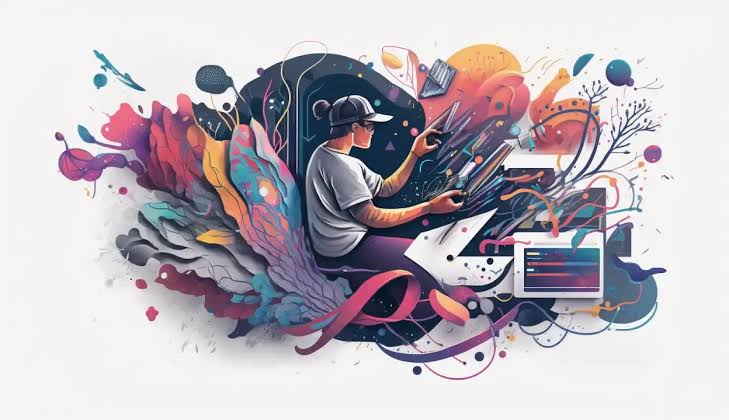AI art and cybernetics represent a profound shift in the relationship between technology and creativity. Together, they are expanding the definition of art, enabling interactive, collaborative, and boundary-breaking forms of expression. They democratize access to creativity while challenging conventional notions of originality and authorship.
Art has always evolved alongside technology, from the invention of the printing press to photography, cinema, and digital design. In the 21st century, artificial intelligence and cybernetics are redefining the boundaries of creativity and reshaping how art is created, shared, and experienced. As of 2025, AI-generated art and cybernetic systems are no longer experimental novelties but influential forces within both creative industries and society at large. The fusion of human imagination with machine intelligence is raising new possibilities, sparking debates, and expanding the meaning of what art can be.
The evolution of AI in art
AI’s role in art began with simple generative algorithms that produced abstract patterns and has advanced to sophisticated models capable of creating photorealistic images, digital paintings, music compositions, and even film scripts. Deep learning techniques, especially generative adversarial networks (GANs) and diffusion models, have made it possible for machines to mimic artistic styles, blend cultural influences, and generate unique pieces that rival human-made art.
Today, platforms powered by AI enable anyone, regardless of artistic training, to create high-quality artworks in seconds. This democratization of creativity is both celebrated and contested, as it challenges traditional notions of artistic skill and authorship.
Cybernetics and interactive creativity
Cybernetics, the study of systems, feedback, and control, plays a critical role in interactive art. Artists have begun to design cybernetic artworks where human actions influence the behavior of machines and vice versa. These systems often use sensors, robotics, and AI algorithms to respond to human movement, speech, or emotions, creating immersive experiences where the boundary between artist, viewer, and machine blurs.
In installations where cybernetic systems interact with audiences, the artwork is not static but dynamic, evolving with every input. This approach reflects the broader cybernetic philosophy that art is not just about expression but about communication and relationships between systems—human, technological, and environmental.
AI as a collaborator in artistic expression
Rather than replacing artists, AI is increasingly seen as a collaborator. Many creators use AI as a tool to explore new visual styles, generate musical variations, or prototype design concepts. For example, digital artists often train AI models on their personal portfolios, allowing the system to generate works that reflect and expand upon their unique style.
Musicians and sound designers employ AI systems to create harmonies or experiment with rhythms that might be difficult to imagine manually. Writers use AI-driven text generators to spark inspiration, brainstorm plots, or even co-author narratives. This symbiotic relationship demonstrates how technology can enhance human creativity rather than diminish it.
The rise of cybernetic performance art
Performance art is also being transformed by AI and cybernetics. Dancers perform alongside robotic partners, musicians play with AI-driven instruments, and actors interact with machine-generated dialogue in real time. These hybrid performances push audiences to reconsider what it means to be human in a world where machines can express movement, sound, and even improvisation.
Cybernetic prosthetics and wearable technologies further expand artistic performance by turning the human body into a technological canvas. Artists equipped with biofeedback sensors or neural interfaces can produce art through brainwaves, heartbeats, or muscle signals, blending biology with technology in profound and sometimes provocative ways.
Redefining authorship and originality
The intersection of AI art and cybernetics raises challenging questions about authorship and originality. If an algorithm creates a painting based on the styles of thousands of artists, who owns the artwork—the programmer, the user, or the AI itself? Similarly, if a cybernetic system generates music in real time based on a dancer’s movements, where does authorship lie?
These debates have led to legal and ethical challenges surrounding copyright, intellectual property, and cultural value. Some argue that AI-generated works should not be protected under traditional copyright laws because they lack human authorship, while others suggest that collaborative human-AI works should be recognized as a new category of creative production.
The democratization of creativity
One of the most transformative aspects of AI art is accessibility. Previously, creating professional-quality art often required years of training and expensive tools. Now, AI-powered platforms allow anyone with a smartphone or computer to produce compelling images, animations, or music. This democratization opens creative opportunities to wider audiences, giving a voice to people who may not have had access to traditional art education.
However, this accessibility also sparks concerns about oversaturation and the dilution of artistic value. If millions of AI-generated artworks flood digital spaces daily, distinguishing meaningful art from mass-produced content becomes more challenging. This shifts the focus of art from production to curation, context, and interpretation.
Impact on cultural and artistic institutions
Art galleries, museums, and auction houses have begun to embrace AI and cybernetic art. AI-generated pieces have been sold at prestigious auctions, sometimes for millions of dollars, signaling recognition from traditional art markets. Interactive cybernetic installations are increasingly featured in global exhibitions, attracting audiences eager to experience the fusion of technology and creativity.
At the same time, critics question whether this trend commercializes AI art at the expense of deeper cultural meaning. Institutions are now challenged to balance the celebration of innovation with the preservation of human-centered artistic traditions.
Ethical and philosophical considerations
The rise of AI art and cybernetics also raises deeper philosophical questions. Can machines truly be creative, or are they merely tools executing human instructions? Does the act of creation require consciousness, or can algorithmic processes suffice? Moreover, what does it mean for humanity if machines can produce works that evoke emotions once thought uniquely human?
These questions spark both excitement and unease. While some view AI art as an extension of human imagination, others worry it may devalue the emotional labor and cultural heritage embedded in traditional art. The future of art will likely involve navigating these tensions between innovation, ethics, and authenticity.
